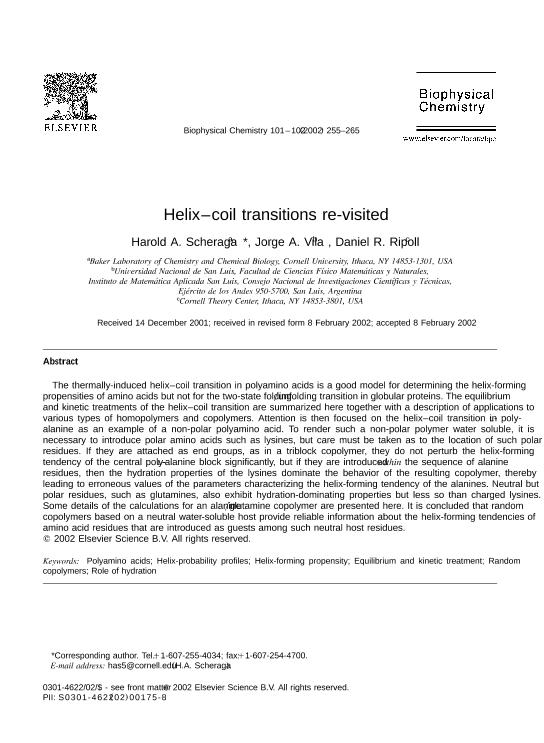Mostrar el registro sencillo del ítem
dc.contributor.author
Scheraga, Harold A.

dc.contributor.author
Vila, Jorge Alberto

dc.contributor.author
Ripoll, Daniel R.
dc.date.available
2020-11-12T14:22:31Z
dc.date.issued
2002-12
dc.identifier.citation
Scheraga, Harold A.; Vila, Jorge Alberto; Ripoll, Daniel R.; Helix-coil transitions re-visited; Elsevier Science; Biophysical Chemistry; 101-102; 12-2002; 255-265
dc.identifier.issn
0301-4622
dc.identifier.uri
http://hdl.handle.net/11336/118253
dc.description.abstract
The thermally-induced helix-coil transition in polyamino acids is a good model for determining the helix-forming propensities of amino acids but not for the two-state folding/unfolding transition in globular proteins. The equilibrium and kinetic treatments of the helix-coil transition are summarized here together with a description of applications to various types of homopolymers and copolymers. Attention is then focused on the helix-coil transition in poly-L-alanine as an example of a non-polar polyamino acid. To render such a non-polar polymer water soluble, it is necessary to introduce polar amino acids such as lysines, but care must be taken as to the location of such polar residues. If they are attached as end groups, as in a triblock copolymer, they do not perturb the helix-forming tendency of the central poly-L-alanine block significantly, but if they are introduced within the sequence of alanine residues, then the hydration properties of the lysines dominate the behavior of the resulting copolymer, thereby leading to erroneous values of the parameters characterizing the helix-forming tendency of the alanines. Neutral but polar residues, such as glutamines, also exhibit hydration-dominating properties but less so than charged lysines. Some details of the calculations for an alanine/glutamine copolymer are presented here. It is concluded that random copolymers based on a neutral water-soluble host provide reliable information about the helix-forming tendencies of amino acid residues that are introduced as guests among such neutral host residues.
dc.format
application/pdf
dc.language.iso
eng
dc.publisher
Elsevier Science

dc.rights
info:eu-repo/semantics/openAccess
dc.rights.uri
https://creativecommons.org/licenses/by-nc-sa/2.5/ar/
dc.subject
EQUILIBRIUM AND KINETIC TREATMENT
dc.subject
HELIX-FORMING PROPENSITY
dc.subject
HELIX-PROBABILITY PROFILES
dc.subject
POLYAMINO ACIDS
dc.subject
RANDOM COPOLYMERS
dc.subject
ROLE OF HYDRATION
dc.subject.classification
Física Atómica, Molecular y Química

dc.subject.classification
Ciencias Físicas

dc.subject.classification
CIENCIAS NATURALES Y EXACTAS

dc.title
Helix-coil transitions re-visited
dc.type
info:eu-repo/semantics/article
dc.type
info:ar-repo/semantics/artículo
dc.type
info:eu-repo/semantics/publishedVersion
dc.date.updated
2020-09-03T19:25:36Z
dc.journal.volume
101-102
dc.journal.pagination
255-265
dc.journal.pais
Países Bajos

dc.journal.ciudad
Amsterdam
dc.description.fil
Fil: Scheraga, Harold A.. Cornell University; Estados Unidos
dc.description.fil
Fil: Vila, Jorge Alberto. Consejo Nacional de Investigaciones Científicas y Técnicas. Centro Científico Tecnológico Conicet - San Luis. Instituto de Matemática Aplicada de San Luis "Prof. Ezio Marchi". Universidad Nacional de San Luis. Facultad de Ciencias Físico, Matemáticas y Naturales. Instituto de Matemática Aplicada de San Luis "Prof. Ezio Marchi"; Argentina
dc.description.fil
Fil: Ripoll, Daniel R.. Cornell Theory Center; Estados Unidos
dc.journal.title
Biophysical Chemistry

dc.relation.alternativeid
info:eu-repo/semantics/altIdentifier/doi/https://doi.org/10.1016/S0301-4622(02)00175-8
dc.relation.alternativeid
info:eu-repo/semantics/altIdentifier/url/https://www.sciencedirect.com/science/article/abs/pii/S0301462202001758?via%3Dihub
Archivos asociados
